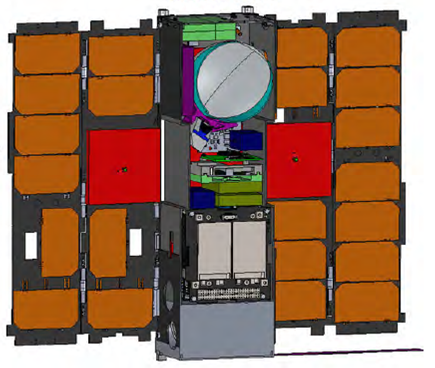Microwave Radiometer Technology Acceleration (MiRaTA) CubeSat
| The Microwave Radiometer Technology Acceleration (MiRaTA) 3U CubeSat | |
|
The MiRaTA 3U CubeSat will validate new ultra-compact and low-power technology for CubeSat-sized microwave radiometers operating near 52-58, 175-191, and 206-208 GHz. It wall also validate new GPS receiver and antenna array technology necessary for CubeSat tropospheric radio occultation sounding. This tests a new approach to radiometer calibration using concurrent GPS radio occultation (GPSRO) measurements. A slow pitch up/down maneuver will be executed once per orbit to permit the radiometer and GPSRO observations to sound overlapping volumes of atmosphere through the Earth's limb, where sensitivity, calibration, and dynamic range are optimal. These observations will be compared to radiosondes, global high-resolution analysis fields, other satellite observations, and with each other using radiative transfer models. The radiometer and GPSRO technology elements, currently at TRL5 but to be advanced to TRL7 at mission conclusion, are functionally independent but highly synergistic, and are all readily accommodated in a single 3U CubeSat to be launched into an ISS orbit at 390km/52° for low-cost validation. |
|
| These new capabilities would directly improve Earth Science measurements in several ways. MiRaTA will demonstrate high-fidelity, well-calibrated radiometric sensing from a nanosatellite platform, thereby enabling new architectural approaches for mission implementation at lower cost and risk with more flexible access to space. In addition, measurement quality can be substantially improved relative to present systems through the use of proximal GPSRO measurements as a calibration standard for radiometric observations, reducing and perhaps eliminating the need for costly and problematic internal calibration targets. This 90-day mission will mark the first ever implementation of co-located radiometer+GPSRO sounding and the first CubeSat implementation of both temperature+humidity radiometric sounding and GPSRO atmospheric sounding. Therefore, MiRaTA will not only validate multiple subsystem technologies, but will also demonstrate new sensing modalities that would dramatically enhance the capabilities of future weather and climate sensing architectures. | |



